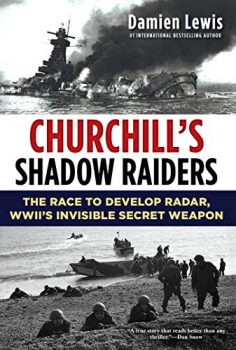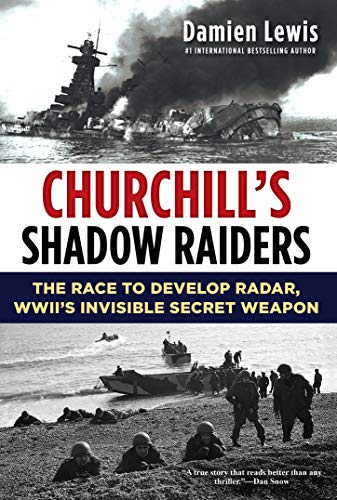
Military historians tend to agree that radar played a singularly important role in the Allied victory in World War II, arguably greater than the decoding of the German Enigma codes (and certainly greater than the atomic bomb, which only ended the war). But British and American sources tend to disagree on where the critical advances in the technology took place. Unsurprisingly, the British highlight the role of British scientists, the Americans that of Americans. However, in fact, it was Nazi scientists whose contributions may have been the most significant. That’s the little-known fact that comes to light in author and filmmaker Damien Lewis‘s fascinating book about the theft of German radar technology, Churchill’s Shadow Raiders.
The English won the Battle of Britain with primitive radar
Although German radar technology came to play a crucial role later in the war, Britain did, indeed, win the Battle of Britain on the strength of its radar defenses as much as on the bravery of its young RAF pilots. Long before September 1939, when World War II broke out, British scientists had pioneered the development of what was then called Radio Detection Finding (RDF).
Churchill’s Shadow Raiders: The Race to Develop Radar, WWII’s Invisible Secret Weapon by Damien Lewis (2020) 416 pages ★★★★★
Two years before Hitler attacked Poland, Britain began erecting a ring of tall Early Warning RDF towers called Chain Home all along the island’s coast. The large radar installations in these towers proved decisive in giving RAF Fighter Command an edge against incoming German bombers. However, those installations were huge and inflexible, and the Germans soon developed a system (the Battle of the Beams) to avoid them.
German radar technology was unknown to the British
Soon, however, British military commanders noticed that its own bombers were also being targeted with ruthless efficiency. The prevailing wisdom was “The bomber will always get through.” But that was most certainly not the case. RAF Bomber Command was losing pilots and crews and precious aircraft at an alarming and ultimately unsustainable rate. Nonetheless, commanders in all branches of the British military resolutely refused to believe that the Germans had radar of their own—and they continued to insist that was the case even when conclusive evidence began accumulating. In the end, it required an intervention by Winston Churchill himself to greenlight a paratroop attack on a German radar facility on the north French coast—an attack not to destroy the installation but to steal it. That attack is the centerpiece of Churchill’s Shadow Raiders.
The early exploits of Britain’s special forces
This is a curious book. Its subtitle, The Race to Develop Radar, is misleading, in that Lewis devotes little attention to the long history of scientific activity in Britain to perfect the technology. The book’s main title, Churchill’s Shadow Raiders, is closer to the mark. In fact, there is virtually no mention of radar in the first quarter of the text, and relatively little in the chapters that immediately follow. The focus is squarely on the founding and early exploits of what came to be called the Special Air Service (SAS)—the paratroop regiment (later a corps) established at the insistence of Winston Churchill to wreak havoc behind German lines. Today, the SAS is the cornerstone of Britain’s special forces. Then, it was a stepchild of the British Army only grudgingly launched by the generals because the Prime Minister would have it no other way.
The first, perilous mission of the Special Air Service (SAS)
Lewis dramatizes the first, perilous mission of the SAS in his book’s opening chapters. Churchill insisted on demonstrating to the British people that their army could strike back at the Axis powers, even though his generals were adamantly opposed. But the Prime Minister won, of course. Thirty-six paratroopers were dropped at a low altitude over southern Italy in February 1941 in Operation Colossus. Their mission was to blow up a massive aqueduct that supplied water to three coastal towns, including a major port used by the Italian military for operations in North Africa. They succeeded, even though all the paratroops were captured and imprisoned by Italian police and one (an Italian citizen) was executed for treason. However, in one of the tragic ironies of war, photographic reconnaissance failed to confirm the destruction of the aqueduct. For a long time afterward, the mission was universally regarded as a failure.
One year later, the SAS achieved a breakthrough
Only when conclusive evidence emerged that the Italian mission had, in fact, succeeded, did Churchill’s allies gain the upper hand in senior military planning circles. However, once again the Prime Minister’s personal intervention was necessary to approve the SAS mission named Operation Biting to steal the German radar technology under heavy guard at Bruneval on the French coast. The operation involved a force of just one hundred twenty paratroops, but hundreds of others were involved as well: a photo-reconnaissance team to produce photos of the site, French maquis to map it out from the ground, Royal Navy ships to rescue the men from the beach at the conclusion of the operation, scientists and technicians to advise the troops on how to dismantle the facility and later to analyze it, and scores of military planners. It was well worth all the effort. The mission proved to be a breakthrough.
A stirring account of the courageous men of the SAS
The paratroops didn’t only succeed in dismantling and spiriting away the German radar technology at Bruneval. They also captured a German radar technician who was only too happy to help British scientists and technicians with “a ‘complete reconstruction of the equipment’ so as to show what it was capable of and, crucially, how to defeat it.” But none of this happened simply because Operation Biting had been well planned (which it was). Naturally, as any military officer would be likely to predict, almost everything went wrong, and it was only through the extraordinary bravery and resourcefulness of the troops in the air (to photograph the German installation), on the ground, and in the English Channel (on the way back) that the mission succeeded. Lewis makes the most of this material. At times, his account reads like a thriller. He does an equally impressive job painting portraits of the eccentric and often brilliant scientists and unconventional military officers involved in organizing and managing the SAS.
The historical setting
Before Pearl Harbor and the American entry into World War II, Britain stood alone against Nazi Germany. The country had barely survived the Battle of Britain and was badly losing the Battle of the Atlantic to Hitler’s U-boats. The news was unrelievably bad, from Dunkirk to Singapore to Oslo, and Winston Churchill was desperate to demonstrate how Britain might regain the offensive, if only to help bolster morale on the home front. And the Prime Minister’s eagerness for a solution to the problem gave rise to the birth of two top-secret special forces: the Special Operations Executive (SOE) in 1940 and the SAS in 1941. Churchill’s Shadow Raiders involves both organizations but is squarely focused on the paratroops who gave the fighters modeled on the Boer Commandos the name Special AIR Service.
Why were the British surprised?
It should have been no surprise to the British that Germany had developed more advanced radar than their own boffins. Although scientific progress had been marked throughout the West for a century, German scientists had been responsible for a disproportionate number of the breakthroughs in medicine, optics, chemistry, pharmaceuticals, and physics before World War II. And “the truth was that there were many ‘discoveries’ of radar, in many parts of the world, and the Germans had been in the forefront.”
About the author
A former war correspondent, Damien Lewis is the author of more than twenty books, most of them military histories or biographies and memoirs. He has also produced twenty films. His books have appeared on bestseller lists in many countries. (The author is not to be confused with the popular British actor, Damian Lewis, who spells his given name in a slightly different way.)
For further reading
I’ve also reviewed a book with a different take on the development of radar in World War II: Tuxedo Park: A Wall Street Tycoon and the Secret Palace of Science that Changed the Course of World War II by Jennet Conant (The amateur scientist who helped deliver radar and the atomic bomb).
You might also be interested in:
- 5 top nonfiction books about World War II (plus many runners-up)
- The 10 best novels about World War II (with 20+ runners-up)
- The 10 most consequential events of World War II
And you can always find my most popular reviews, and the most recent ones, plus a guide to this whole site, on the Home Page.


























